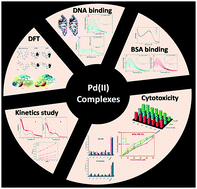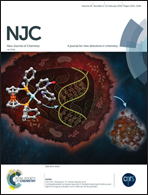Synthesis, biological evaluation, substitution behaviour and DFT study of Pd(ii) complexes incorporating benzimidazole derivative†
Abstract
To achieve potent yet specific antitum agents, a series of palladium(II) complexes (C1–C6) employing the carrier ligand 2-aminomethylbenzimidazole with DNA intercalating property and diverse ancillary groups (chloride, aqua, thiol) were synthesized and characterized. The kinetic parameters of the reactivity of the diaqua complex C2 towards selected sulphur-containing biomolecules were evaluated under pseudo-first order reaction conditions. Theoretical calculations such as NBO and TD-DFT were found to corroborate with spectroscopic results. Intercalative/groove binding nature of calf-thymus DNA (CT-DNA) interaction for the complexes was confirmed by various physico-chemical techniques and molecular docking. A strong association of the complexes with bovine serum albumin (BSA) via a static mechanism was demonstrated by absorption and emission measurements. The anti-proliferative effects of the complexes were tested against human breast tumor MDA-MB-231, human lung carcinoma A549 and human hepatocellular liver carcinoma HepG2. The complexes exhibited inhibitory effects greater than that exhibited by recognized drug cisplatin on the MDA-MB-231 cell line. Notably, the growth inhibition as well as oxidative stress elicited by the complexes in non-malignant cell lines L6 myotubes (rat myoblasts) and HEK-293 (human embryonic kidney cells) was much less than by cisplatin.


 Please wait while we load your content...
Please wait while we load your content...